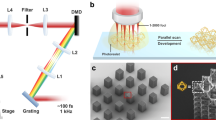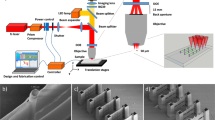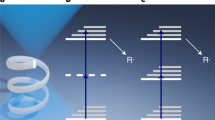Abstract
Two-photon excitation provides a means of activating chemical or physical processes with high spatial resolution in three dimensions and has made possible the development of three-dimensional fluorescence imaging1, optical data storage2,3 and lithographic microfabrication4,5,6. These applications take advantage of the fact that the two-photon absorption probability depends quadratically on intensity, so under tight-focusing conditions, the absorption is confined at the focus to a volume of order λ3 (where λ is the laser wavelength). Any subsequent process, such as fluorescence or a photoinduced chemical reaction, is also localized in this small volume. Although three-dimensional data storage and microfabrication have been illustrated using two-photon-initiated polymerization of resins incorporating conventional ultraviolet-absorbing initiators, such photopolymer systems exhibit low photosensitivity as the initiators have small two-photon absorption cross-sections (δ). Consequently, this approach requires high laser power, and its widespread use remains impractical. Here we report on a class of π;-conjugated compounds that exhibit large δ (as high as 1, 250 × 10−50 cm4 s per photon) and enhanced two-photon sensitivity relative to ultraviolet initiators. Two-photon excitable resins based on these new initiators have been developed and used to demonstrate a scheme for three-dimensional data storage which permits fluorescent and refractive read-out, and the fabrication of three-dimensional micro-optical and micromechanical structures, including photonic-bandgap-type structures7.
This is a preview of subscription content, access via your institution
Access options
Subscribe to this journal
Receive 51 print issues and online access
$199.00 per year
only $3.90 per issue
Buy this article
- Purchase on Springer Link
- Instant access to full article PDF
Prices may be subject to local taxes which are calculated during checkout



Similar content being viewed by others
References
Denk, W., Strickler, J. H. & Webb, W. W. Two-photon laser scanning fluorescence microscopy. Science 248, 73–76 (1990).
Strickler, J. H. & Webb, W. W. Three-dimensional optical data storage in refractive media by two-photon point excitation. Opt. Lett. 16, 1780–1782 (1991).
Parthenopoulos, D. A. & Rentzepis, P. M. 3-Dimensional optical storage memory. Science 245, 843–845 (1989).
Strickler, J. H. & Webb, W. W. Two-photon excitation in laser scanning fluorescence microscopy. SPIE Proc. 1398, 107–118 (1990).
Wu, E. S., Strickler, J. H., Harrell, W. R. & Webb, W. W. Two-photon lithography for microelectronic application. SPIE Proc. 1674, 776–782 (1992).
Maruo, S., Nakamura, O. & Kawata, S. Three dimensional microfabrication with two-photon-absorbed photopolymerization. Opt. Lett. 22, 132–134 (1997).
Yablonovitch, E. Photonic crystals. J. Mod. Opt. 41, 173–194 (1994).
Albota, M.et al. Design of organic molecules with large two-photon absorption cross sections. Science 281, 1653–1656 (1998).
Odian, G. Principles of Polymerization2nd edn (Wiley, New York, (1981)).
Feiertag, G.et al. Fabrication of photonic crystals by deep x-ray lithography. Appl. Phys. Lett. 71, 1441–1443 (1997).
Wu, L., Li, F., Tang, S., Bihari, B. & Chen, R. T. Compression-molded three-dimensional tapered polymeric waveguides for low-loss optoelectronic packaging. IEEE Photon. Technol. Lett. 9, 1601–1603 (1997).
Bustillo, J. M., Howe, R. T. & Muller, R. S. Surface micromachining for microelectromechanical systems. Proc. IEEE 86, 1552–1574 (1998).
Acknowledgements
We thank S. Fraser and the Biological Imaging Center, California Institute of Technology, for use of a two-photon scanning laser microscope system, and S. Thayumanavan for synthetic precursors used in this work. H.R. thanks the Alexander von Humboldt Stiftung for a postdoctoral fellowship through the Theodore Lynen Program. This work was supported by the Ballistic Missile Defense Initiative Organization (at the Jet Propulsion Laboratory) and by the Office of Naval Research (through CAMP at the University of Arizona), the NSF and the Air Force Office of Scientific Research (at the California Institute of Technology).
Author information
Authors and Affiliations
Corresponding author
Rights and permissions
About this article
Cite this article
Cumpston, B., Ananthavel, S., Barlow, S. et al. Two-photon polymerization initiators for three-dimensional optical data storage and microfabrication. Nature 398, 51–54 (1999). https://doi.org/10.1038/17989
Received:
Accepted:
Issue Date:
DOI: https://doi.org/10.1038/17989
This article is cited by
-
Micro- and nanofabrication of dynamic hydrogels with multichannel information
Nature Communications (2023)
-
Second harmonic generation of femtosecond laser pulses of central wavelength 1000 nm, 1100 nm and 1300 nm using ZnO nanorods
Optical and Quantum Electronics (2023)
-
A review on additive manufacturing of wave controlling metamaterial
The International Journal of Advanced Manufacturing Technology (2023)
-
Two Photon Absorption Properties of CBHB and DEABHB Single Crystals for Optical Limiting Applications
Journal of Fluorescence (2023)
-
Crystal Structure, Hirshfeld Analyses, Spectral, Thermal, Two-Photon Absorption Properties and Optical Limiting Applications of Novel 4-Fluoro-N-[4-(diethylamino)benzylidene]aniline (FDEABA)
Journal of Chemical Crystallography (2023)
Comments
By submitting a comment you agree to abide by our Terms and Community Guidelines. If you find something abusive or that does not comply with our terms or guidelines please flag it as inappropriate.



